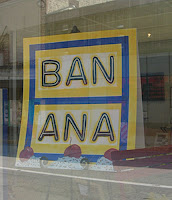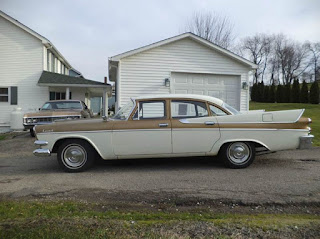East Coast At Last
©2013 Text & Photos by LeeZard
Tuesday August 18 – Ft. Loramie, OH-Latrobe, PA
Leaving Ft. Loramie, I drive a variety of Ohio
state roads for a few miles each. The landscape is still primarily agricultural
and it is still mostly corn. No surprise, not only is corn the biggest crop in
America, we are the largest producers in the world. The U.S. Department of
Agriculture estimates the 2013 yield will be 13.8-billion bushels, up from
10.8-billion in 2012.
Not unlike Ohio, the many small towns along the
way show their age with the classic colonial buildings along their main
thoroughfares. There is so much history here. I wish I had time to stop and
soak it all up. This was the post-revolutionary “Northwest” as those New
Americans began to explore their continent. Not only did they explore and build
overland, they built canals to move their goods and they fought Indian Wars to
establish new territories. Many of these towns – and their buildings – date
from the early-to-mid 19th Century.
Finally I am on U.S. 33 North, a four-lane
freeway, and the scenery starts to change. The number of farms diminishes and
at first there are more groups of trees and those groups soon become forests.
As agriculture fades I begin to see more – and larger – manufacturing plants.
The biggest one so far is the Honda plant in Marysville, OH. It was the first
Japanese auto plant in America (1982) and has its own interchange. Forty two hundred
people work there.
Finally, I become slave to I-70 east. There is
nothing but thick forest on either side and the land begins to roll as I near
the Pennsylvania State Line. I cross into Western Pennsylvania. After more than
5,000 meandering miles and 11 states across the middle of America I am on the
East Coast. I am reminded this used to be Steel Country as I pass through
Bethlehem, PA. Those days, and many of the mills, are gone changing the
economies here forever. Some towns haven’t fully recovered yet.
I am north of the Allegheny Mountains but still,
the terrain becomes rockier and I notice the overloaded Jeep is slowing more
often as it climbs the grades. I exit the freeway at New Stanton. U.S. Rtes.
119 and 30 will take me to Latrobe.
Some people here pronounce it LUH trobe while
others say LAY trobe. Arnold Palmer always called it LUH trobe so that’s my
preferred pronunciation. I chose this city of 8,235 people (down a little over
one percent from the 2010 Census) for several reasons. Aside from its proximity
to camping in the beautiful Keystone State Park, Latrobe is the hometown of two
people for whom I have the greatest respect.
While I am certainly not a golf fan, I’ve always
been an Arnie Palmer fan. Don’t ask me why. Latrobe is also the boyhood home of
Fred Rogers, the famous kid show host Mr. Rogers. While I found his style
somewhat unctuous, I liked the positive and empowering messages he had for
kids. But, neither Arnold Palmer nor Fred Rogers are the most famous thing to come out of Latrobe, PA. That
honor goes to the banana split!

 In 1904 23-year-old David Strickler was an
apprentice at Latrobe’s Tassel Pharmacy and Soda Fountain. Strickler enjoyed
making up new ice cream combinations for customers and one day came up with the
banana-based triple scoop sundae. Tassel’s charged 10¢
for the new concoction, twice the price of a regular sundae. Word quickly
spread by word-of-mouth and in print until everyone in America knew about it.
Latrobe celebrates its most famous export every year in August with Banana Split
Days. I missed this year’s bash by a few days.
In 1904 23-year-old David Strickler was an
apprentice at Latrobe’s Tassel Pharmacy and Soda Fountain. Strickler enjoyed
making up new ice cream combinations for customers and one day came up with the
banana-based triple scoop sundae. Tassel’s charged 10¢
for the new concoction, twice the price of a regular sundae. Word quickly
spread by word-of-mouth and in print until everyone in America knew about it.
Latrobe celebrates its most famous export every year in August with Banana Split
Days. I missed this year’s bash by a few days. |
| Carpenter Steel Mill |
Only 43 miles southeast of
Pittsburgh, Latrobe still has a very rural feel to it. Rolling forestland
surrounds the city. Steel used to drive the town’s economy. Now, there is only
one large mill remaining, Carpenter Steel and a few smaller mills. It is not
even the largest employment sector in Latrobe. Three local hospitals employ more than 1,000 people between them.
David Cullaney is 49-years old. His
family has owned and operated the town’s largest bakery for 65-years. “This has
always been a distressed area,” he tells me. The numbers bear that out. Per
capita income is only $21,393, $6,500 less than the entire state.
Unemployment figures and the housing
market show the recession hit Latrobe the hardest in early 2010 and into 2011.
Cullaney says, “At worst our business dropped about 20 percent. We provide
baked goods for a lot of restaurants in town and along the highway; people just
weren’t going out to eat anymore. Our business was never threatened, though;
weddings, baked goods for homes and fundraisers got us through.”
 Throughout my journey I’ve been looking for a
law enforcement perspective. Other than my near apprehension and almost
interview in the Missouri Ozarks, no police officer would talk to me – until I met Sgt. Nunzio Santo Columbo walking a beat in downtown Latrobe. At 30 years
on the force he is the senior cop in the city. This is clearly his town as
evidenced by the way he stops and talks to people in a personable and low-key
manner. He certainly has a good perspective on the entire community.
Throughout my journey I’ve been looking for a
law enforcement perspective. Other than my near apprehension and almost
interview in the Missouri Ozarks, no police officer would talk to me – until I met Sgt. Nunzio Santo Columbo walking a beat in downtown Latrobe. At 30 years
on the force he is the senior cop in the city. This is clearly his town as
evidenced by the way he stops and talks to people in a personable and low-key
manner. He certainly has a good perspective on the entire community.
“In 2009 you started to see the decline in
business,” he says. “The steel mills started cutting hours. The largest
hospital had to sell out and the new owners cut a lot of services. They went
from about 1,200 employees to about 500 now.”
I asked Sgt. Columbo (He was NOT wearing a
rumpled trench coat) what he saw as a police officer. “It kept me busy, I’ll
tell ya that, lots of overtime. We had a lot more property crime, people
stealing from the cars, a lot of bad checks, drug abuse went up and we had a
lot more alcohol related calls.”
“More violence?” I ask.
“No, not really,” Columbo replies, “we don’t
have a lot of violent crime here but people were taking what they needed.”
Luckily, he tells me, only one position was lost
in the department and that due to attrition. Before letting the good Sargent
continue his rounds, I get his recommendation for the best Italian restaurant
in LUH trobe.



Comments